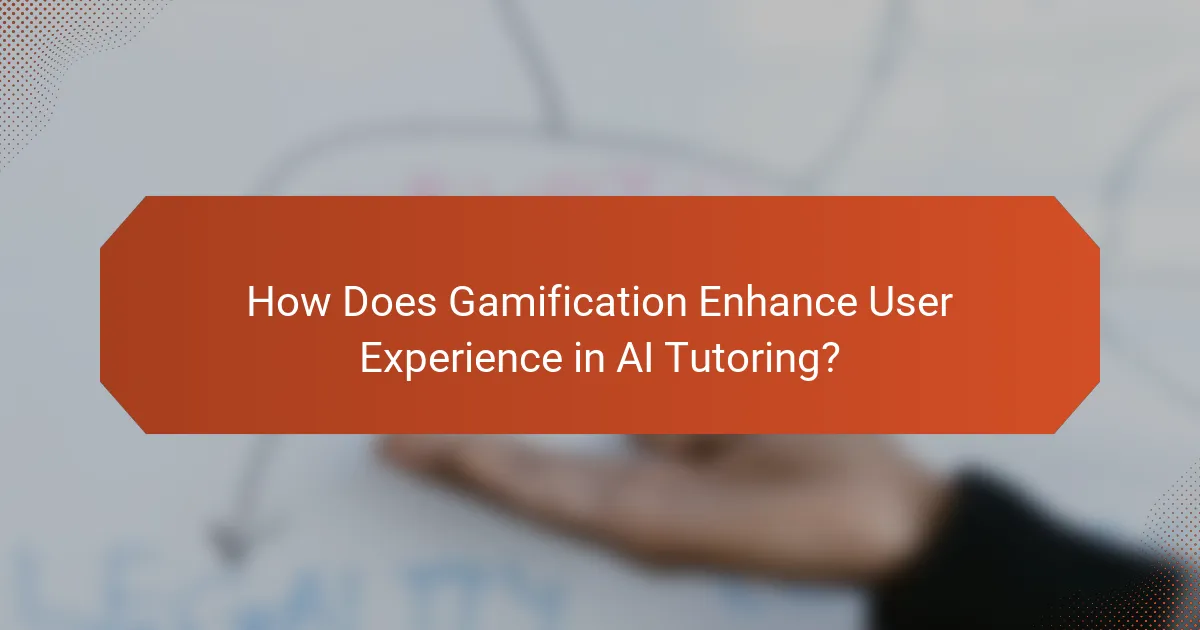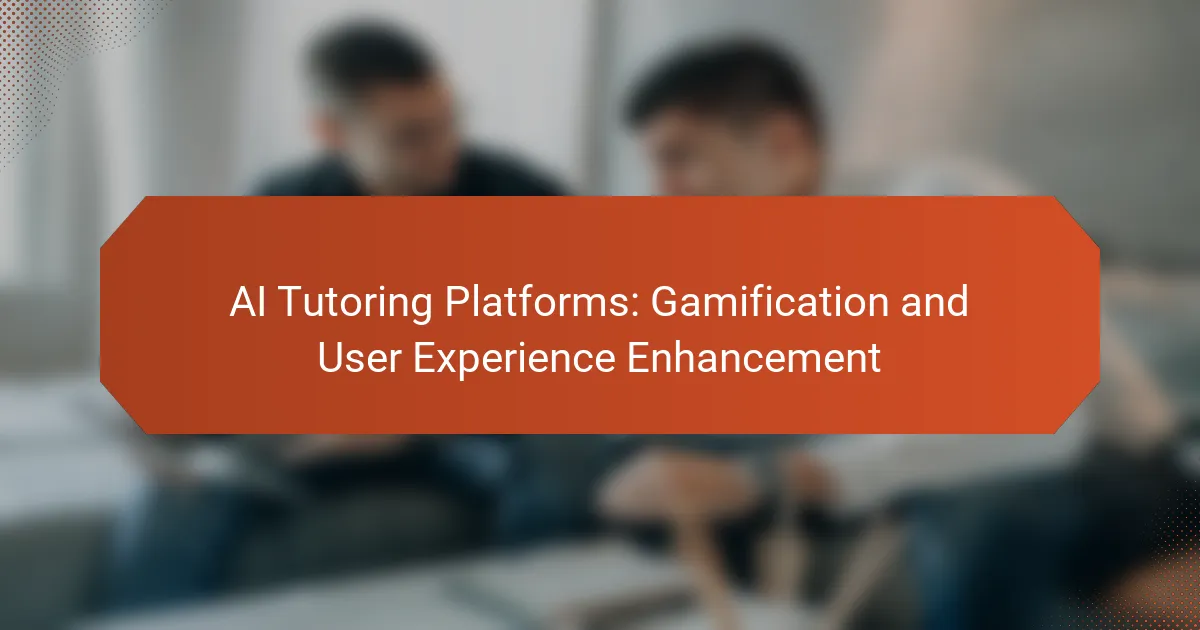AI tutoring platforms are revolutionizing education by integrating gamification to create engaging and interactive learning experiences. These platforms not only motivate students but also enhance retention through game-like elements, making learning both enjoyable and effective. When choosing an AI tutoring solution, it’s essential to focus on features that promote personalized learning and user engagement, such as adaptive algorithms and real-time feedback.

What Are the Best AI Tutoring Platforms for Gamification?
The best AI tutoring platforms for gamification enhance learning through engaging, game-like experiences. These platforms use interactive elements to motivate students and improve retention, making education more enjoyable and effective.
Khan Academy
Khan Academy offers a comprehensive learning experience with gamified elements such as badges and energy points. Students earn rewards for completing lessons, which encourages them to progress through various subjects at their own pace.
The platform’s personalized dashboard allows learners to track their progress and set goals, making it easier to stay motivated. This self-directed approach is particularly beneficial for students who thrive on autonomy in their learning journey.
Duolingo
Duolingo is renowned for its gamified language learning experience, using a points system and levels to engage users. Each lesson feels like a game, with immediate feedback and rewards for completing exercises, which keeps learners coming back.
The app incorporates fun challenges and streaks, motivating users to practice daily. This approach is effective for language acquisition, as it encourages consistent practice and reinforces learning through repetition.
DreamBox Learning
DreamBox Learning focuses on math education and employs gamification to enhance user experience. The platform adapts to each student’s learning style, providing personalized lessons that adjust in difficulty based on performance.
Gamified features like rewards and interactive games make math more engaging for students. This approach not only improves understanding but also fosters a positive attitude towards learning challenging concepts.
Smart Sparrow
Smart Sparrow offers adaptive elearning solutions that incorporate gamification to enhance student engagement. The platform allows educators to create interactive lessons that adapt to individual student needs, making learning more personalized.
Features such as branching scenarios and real-time feedback help maintain student interest. This adaptability is crucial in catering to diverse learning styles and ensuring that all students can progress effectively.
Edmodo
Edmodo combines social networking with educational tools, incorporating gamification to enhance user experience. Teachers can create assignments that include points and badges, fostering a competitive yet collaborative environment among students.
This platform encourages interaction and peer support, which can lead to improved learning outcomes. By integrating gamified elements, Edmodo helps students stay engaged and motivated in their studies.

How Does Gamification Enhance User Experience in AI Tutoring?
Gamification enhances user experience in AI tutoring by incorporating game-like elements that make learning more interactive and enjoyable. This approach increases student engagement, motivation, and provides clear metrics for tracking progress.
Increased Engagement
Gamification boosts engagement by transforming traditional learning into an interactive experience. Features like quizzes, challenges, and leaderboards encourage students to participate actively rather than passively consuming information.
For example, an AI tutoring platform might include timed quizzes where students compete for high scores, fostering a sense of urgency and excitement. This competitive aspect can lead to longer study sessions and a deeper understanding of the material.
Motivation through Rewards
Reward systems are a key component of gamification, providing incentives for students to complete tasks and achieve learning goals. These rewards can range from virtual badges to points that can be redeemed for real-world benefits, such as discounts on future courses.
Implementing a tiered reward system can motivate students to reach higher levels of achievement. For instance, students might earn a badge for completing a module, which can encourage them to tackle more challenging content to earn additional rewards.
Progress Tracking
Gamified AI tutoring platforms often include progress tracking features that allow students to visualize their learning journey. This can be in the form of progress bars, achievement dashboards, or detailed reports showing areas of strength and those needing improvement.
Clear progress tracking helps students set realistic goals and stay focused on their learning objectives. For instance, a platform might show that a student has completed 70% of a course, motivating them to finish the remaining sections to achieve 100% completion.

What Features Should You Look for in AI Tutoring Platforms?
When selecting an AI tutoring platform, prioritize features that enhance personalized learning and user engagement. Key aspects include adaptive learning algorithms, a user-friendly interface, and real-time feedback mechanisms.
Adaptive Learning Algorithms
Adaptive learning algorithms tailor educational content to individual student needs, adjusting difficulty and topics based on performance. This personalization helps maintain engagement and improves learning efficiency.
When evaluating platforms, look for those that utilize machine learning to analyze student interactions and adapt in real-time. Effective systems can adjust content every few minutes, ensuring that learners are consistently challenged without feeling overwhelmed.
User-Friendly Interface
A user-friendly interface is crucial for minimizing distractions and enhancing the learning experience. The platform should be intuitive, allowing students to navigate easily through lessons, quizzes, and resources.
Consider platforms that offer customizable dashboards, clear navigation menus, and visually appealing layouts. A well-designed interface can significantly reduce the learning curve, enabling students to focus on their studies rather than struggling with technology.
Real-Time Feedback
Real-time feedback is essential for effective learning, as it allows students to understand their mistakes and correct them immediately. Look for platforms that provide instant assessments and suggestions for improvement after each exercise.
Platforms that offer detailed performance analytics can help students track their progress over time. Features such as progress reports and personalized recommendations can enhance motivation and guide learners toward their goals.

How Do Pricing Models Vary Among AI Tutoring Platforms?
Pricing models for AI tutoring platforms can differ significantly, impacting user accessibility and engagement. Common models include subscription-based pricing, freemium options, and pay-per-use structures, each offering unique benefits and considerations.
Subscription-Based Pricing
Subscription-based pricing typically involves a monthly or annual fee for access to the platform’s full range of features. This model often provides unlimited usage, making it appealing for users who need regular tutoring support.
Prices can range from around $10 to $50 per month, depending on the platform’s offerings and the depth of content available. Users should consider their learning frequency and budget when selecting a subscription plan.
Freemium Models
Freemium models offer basic services for free while charging for premium features. This approach allows users to explore the platform without financial commitment, which can be particularly beneficial for those uncertain about long-term investment.
Common premium features may include advanced analytics, personalized tutoring sessions, or access to exclusive content. Users should evaluate whether the free version meets their needs or if the upgrades justify the cost.
Pay-Per-Use Options
Pay-per-use options charge users based on the specific services they utilize, such as individual tutoring sessions or access to particular resources. This model can be cost-effective for users who need occasional assistance rather than regular tutoring.
Rates may vary widely, often ranging from $5 to $30 per session, depending on the tutor’s expertise and the platform’s reputation. Users should track their usage to ensure they are getting value for their spending and consider potential long-term costs if they require frequent help.

What Are the Benefits of Gamification in Education?
Gamification in education enhances engagement and motivation, leading to improved learning outcomes. By incorporating game-like elements, such as points, badges, and leaderboards, educational platforms can create a more interactive and enjoyable experience for learners.
Improved Retention Rates
Gamification significantly boosts retention rates by making learning more engaging and memorable. When students participate in interactive activities, they are more likely to remember the material compared to traditional methods.
For instance, platforms that use quizzes with immediate feedback and rewards can increase retention by encouraging repeated engagement with the content. This approach can lead to retention rates that are often higher than those achieved through conventional study techniques.
To maximize retention, educators should focus on incorporating diverse game elements that cater to different learning styles. Regularly updating challenges and rewards can keep students motivated and prevent boredom, ensuring sustained interest in the subject matter.
